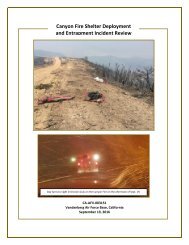Final Report to the Joint Fire Science Program
13-1-04-45_final_report
13-1-04-45_final_report
You also want an ePaper? Increase the reach of your titles
YUMPU automatically turns print PDFs into web optimized ePapers that Google loves.
Coop & Magee P-J Fuel Treatment Effects 12/31/2016<br />
Analysis<br />
We estimated multi-scale occupancy (MacKenzie et al., 2006; Nichols et al., 2008) for 31 bird<br />
species in <strong>the</strong> piñon-juniper bird community using a modified hierarchical approach (Pavlacky et<br />
al., 2012). We developed a three- step process <strong>to</strong> estimate multi-scale occupancy for each bird<br />
species which that included: 1) modeling detection probabilities (p) using model selection <strong>to</strong><br />
determine <strong>the</strong> <strong>to</strong>p detection model, 2) determining <strong>the</strong> most explana<strong>to</strong>ry treatment effect model<br />
on avian occupancy at local (θ = <strong>the</strong>ta) and landscape (Ψ = psi) scales, and finally 3) modeling<br />
covariate effects on landscape and local scale occupancy. Model development and analysis was<br />
done using <strong>Program</strong> Mark 8.0 (http://www.cnr.colostate.edu/~gwhite/mark/mark.htm; White and<br />
Burnham, 1999). In addition <strong>to</strong> avian point count data, we included 7 landscape scale covariates<br />
(year-since-treatment, mean annual temperature, mean annual precipitation, elevation, heat load<br />
index, forest cover at 10-ha scale and forest cover at 100-ha scale) and 11 local scale covariates<br />
(bare ground, herbaceous cover, shrub cover, vegetation height, standard deviation of vegetation<br />
height, number of stems of live trees, number of stems of live juniper, number of stems of piñon<br />
pine, basal area of live trees, basal area of junipers, and basal area of piñon pine).<br />
To convert number of intersections of down woody fuels <strong>to</strong> fuel mass at each sample site, we<br />
used <strong>the</strong> composite (multi-species) equations of Brown (1974). Because <strong>the</strong> planar intersect<br />
method may yield low estimates of surface fuels in mulched fuelbeds, we also used <strong>the</strong><br />
predictive equations developed by Battaglia et al. (2010) for P-J masticated fuelbeds <strong>to</strong> estimate<br />
<strong>to</strong>tal mulch fuel load (litter, duff, 1- and 10-hour fuels) within treatments, though estimates<br />
generated from <strong>the</strong>se treatment-specific equations cannot be directly compared <strong>to</strong> those from<br />
untreated sites. Herbaceous and live woody surface fuels (shrubs) volumes were calculated from<br />
<strong>the</strong> vegetation point-line intercept transects (percent cover x height) and multiplied by 0.8 kg m -3<br />
for herbs and 1.8 kg m -3 for shrubs. Fuelbed depth was calculated as <strong>the</strong> mean litter depth plus<br />
mean <strong>to</strong>p “hit” height of any plant or down woody fuel. Canopy base height (CBH) was<br />
calculated as <strong>the</strong> mean crown base height (Sando and Wick, 1972; Ruiz-González and Álvarez-<br />
González, 2011) of all trees in each sample site. Canopy bulk density (CBD) was calculated from<br />
allometric equations fitted <strong>to</strong> each sampled tree by species at each site (Brown, 1978; Grier et al.,<br />
1992; Weaver and Lund, 1982). We followed Linn et al. (2013) in calculating CBD of piñonjuniper<br />
woodlands as <strong>the</strong> <strong>to</strong>tal of canopy foliage + all twigs < 2 mm diameter.<br />
To characterize general patterns of plant community composition in untreated and masticated<br />
sites, and <strong>the</strong>ir associations with shifts in canopy cover, ground cover, <strong>to</strong>pography, and climate,<br />
we conducted a non-metric multidimensional scaling (NMS) using R package ‘vegan’ (Oksanen<br />
et al., 2016). This analysis utilized coverages of 142 plant taxa averaged across all 12 transects at<br />
each of 48 sites (24 mastication treatments and 24 corresponding controls); cover was calculated<br />
as <strong>the</strong> <strong>to</strong>tal number of “hits” on <strong>the</strong> three point-line-intercept transects divided by <strong>the</strong> number of<br />
sample points (n = 102). We examined <strong>the</strong> relationships between ordination axes and treatment,<br />
cover by plant life form types (trees, shrubs, forbs, and graminoids) and species, ground cover,<br />
<strong>to</strong>pography (elevation, slope, and heat load index), and regional climate gradients. To assess<br />
treatment impacts on non-native plant species we used paired t-tests <strong>to</strong> test for differing richness<br />
and <strong>to</strong>tal cover, and a Wilcoxon signed rank test <strong>to</strong> test for differing occurrence, in treatment vs.<br />
6




